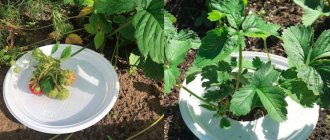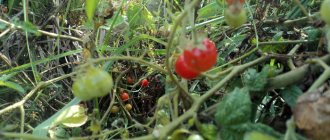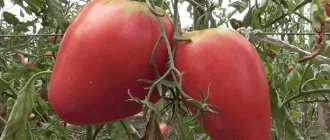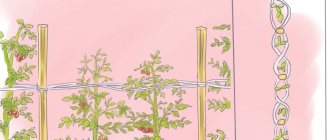Why tie it up at all?
With the help of proper tying, you can correctly form bushes. A correctly carried out procedure helps to increase productivity, faster ripening of fruits and prevent the death of the bush from one of the most common problems - a broken trunk.
Tying is necessary for medium and tall bushes. Tomato garter will help in solving the following problems:
- Watering the root zone of the bush, without damaging the tops and fruits. This is necessary to prevent sunburn.
- Formation of more ovaries.
- Protect the flowers and fruits of the plant from ants and other pests in the soil.
- Checking the plant to reduce the risk of rotting of the trunk and leaves from excess moisture.
- Strengthening the stem, taking the correct shape without bending.
- Prevent stems from becoming brittle under the weight of ripening fruits.
- Ensure uniform penetration of sunlight.
- Make the spraying procedure easier and more effective.
- Make the processes of weeding and pinching easier.
It is important to know that tying is done several times as needed.
Material for production
To make stakes, a variety of improvised means are used - branches and trunks of bushes, metal fittings, fiberglass and plastic elements, and of course you will need ropes for tying up tomatoes.
Tree
Wooden supports are valued for their low cost. The service life reaches 10 years or more. The bark is removed in advance to avoid the formation of roots. You can prevent rapid rotting of the part located in the ground by treating the end of the stick with resin. You can first burn the sections in a fire. Roughness is removed by sanding.
What can be used:
- long or tree branches - from poplar, oak, acacia, linden;
- trunks of wild bushes;
- shovel cuttings;
- fence picket.
The length of the sticks varies from 1 to 2 m. They are based on the tallness of the varieties.
Metal
Tying tomatoes on metal rods is a good option. Durable parts are convenient to insert into the soil and remove at the end of the season. They are distinguished by their reliability and strength. Reinforcement for tomatoes is a valuable material with a long service life, does not rot, does not break, and can withstand maximum loads. The only negative is the high cost of new materials. They are successfully replaced with recyclable materials - pipes, fittings from repair and construction work.
The optimal diameter is 5-8 mm. The height is selected taking into account the length of the shoots of the varieties
Fiberglass
Tomato stakes made of fiberglass reinforcement are an excellent choice for securing bushes. Includes an alloy of metal and glass, which adds strength.
Choose columns up to 10 mm thick. Cut into elements of 1.5-1.7 m. This is a universal length that is suitable for indeterminates.
Advantages of fiberglass:
- does not bend;
- does not break;
- resistant to chemical triggers;
- resistant to corrosion.
Plastic
Sold in agricultural stores. Sufficiently strong stakes look neat in the beds and are easy to use. For greater reliability, choose plastic tubes with metal rods inside.
How to tie tomatoes in open ground
Experienced summer residents use several technologies for tying up plants. Each gardener decides independently how to tie up tomatoes.
Traditionally, the procedure is performed using the following tools:
- pegs;
- cells;
- trellises;
- caps;
- hooks
Pegs
Even a novice gardener can properly tie tomatoes with pegs. The circuit is so simple that it is used everywhere. In the immediate vicinity of the bush, a peg is installed in the ground to which the plant will be tied.
Experts identify several rules that are important to follow when using this method of gartering:
- The maximum support length for tall bushes is 2.5 meters, for medium ones – 2 meters.
- The support is immersed in the ground to a depth of about 60-80 centimeters and rises above the bush by 20-30 centimeters from the maximum possible length.
- The distance from the trunk to the peg is from 10 to 12 centimeters.
Tomato gartering in open ground using stakes is done using a special technology:
- first the rod is installed next to the plant;
- then tie a string around the peg;
- then they tie a tie around the trunk of the plant so that it is not strongly pulled towards the support;
- when the plant grows, repeat the procedure with shoots located above.
You can use metal and wooden stakes for garters. To ensure that the latter serve for a long time and do not rot from moisture, the workpiece is pre-fired.
Cells
We build supports around each bush from large cells, consisting of several vertically located supports with horizontal jumpers. This structure is dug into the ground to a depth of twenty centimeters.
The service life of such structures can reach five years.
Trellis
Anyone can properly tie tomatoes using trellises. It is important to follow the technology:
- Two pegs are dug in at an equidistant distance from each other along the edges of the bed. For very wide areas, intermediate stakes can be placed.
- The pegs are connected using horizontal jumpers from bottom to top. The distance from the ground to the lowest jumper is about 20 centimeters.
The trellis can be made of wooden sticks, rods, or metal wire.
Caps
Caps or pyramids are homemade wigwams to which several bushes can be tied at once. It is very convenient to tie tomatoes in open ground using such preparations.
To create the structure, you need three vertical supports secured with jumpers.
Hooks
This design is ideal for tall varieties of tomatoes. A wire is stretched between two pegs, on which there is a series of loops, through which the bushes are tied.
Characteristics of culture
In Russian, the names of this vegetable plant of the nightshade family, “tomato” and “tomato,” despite their different origins, have equal rights. South America is considered the birthplace of the culture.
Agrotechnical data:
- Tomatoes require a temperature of 22-25 0C for growth and development. When the air temperature is below 10 0 C, the ovary disappears, since the pollen does not ripen and the flower is not pollinated. The tomato is a self-pollinating plant.
- It does not tolerate high air humidity, but the root system requires a lot of water for fruit growth.
- With a lack of light, the development of culture is delayed.
- It can grow in almost any soil if properly fertilized.
Depending on the structure of the bush, the shape and nature of the leaves, and the thickness of the stem, it is divided into three varieties:
Pegs for tomato garter
- standard;
- non-standard;
- potato
Reproduces:
- seeds;
- cuttings;
- stepsons (side shoots).
The root system is taproot type. It forms quickly and goes to great depths. Stem up to two meters or more, erect or lodging. The leaves are divided into lobes, tender with slight fluff. The flowers are small, collected in a brush, of various shades. The fruits are juicy, of different colors and shapes.
Whether the crop should be considered a berry, which it is from a botanical point of view, is not a relevant question for practicing gardeners. It is much more important to grow a healthy crop. One of the important conditions for this is staking the plant.
Tying in greenhouses
Growing tomatoes in greenhouses has a number of features. Since the amount of free space in the structure is limited, the following types of garter are used:
- Bow. A wire is stretched between the rows, to which each bush is fixed using the figure-of-eight method.
- Using clothespins. These are ready-made devices that can be purchased at any summer resident store. They allow you to fix the plant to any type of support.
Practicality and economy: fiberglass reinforcement in the country
Country houses, territory design, garden and vegetable garden, as well as many other factors require us to spend certain expenses.
Today we will try to significantly reduce them by using only one material - fiberglass reinforcement, and at the same time we will not lose an ounce of quality! When we come to our summer cottage, we assess the situation every day... it’s time to pull down the house, build a new shower and makeshift shed, put a greenhouse on the right, and plant tomatoes in the garden on the left. There are thousands of such solutions, but each of them depends on free time and financial costs, and if we can find time to work at the dacha at least on a day off, then money does not come to us so easily once a week. There is only one thing left to do - save on buildings, decoration, and growing some plants. But in order not to limit yourself in the dacha business, to continue to build and achieve maximum results, it is not at all necessary to abandon objects or part of the garden; you can always choose related materials for supply, which will cost a little less.
How to form a bush
All varieties of tomatoes are formed by the formation of lateral shoots. The taller the plant, the more shoots there should be. However, an excessive number of shoots reduces the yield.
The procedure is simple: with hands dipped in a weak solution of potassium permanganate, pinch off excess shoots at a distance of 1-2 centimeters from the trunk.
The shoots need to be pinched. The optimal time for the procedure is morning.
Tying and pinching are fairly simple procedures that can be assigned to any family member.
Common mistakes
Now a few words about the mistakes that summer residents make when tying up tomatoes.
- Using the wrong material. Here we can mention too hard and thin ropes, and the use of last year’s materials.
- The garter is done incorrectly: too low or too high.
- Using the wrong supports: too low, or, conversely, too high.
- The timing of the procedure was chosen incorrectly. It’s unnecessary to say anything here. Bushes need to be tied up in time to direct their growth and ensure stability.
Photo of tomato
Methods of growing tomatoes
Tomatoes are grown outdoors and in greenhouse conditions in horizontal and vertical positions.
Berry to berry: what to plant next to raspberries
The vertical growing method allows:
- Plant a large number of plants in a relatively small sown area;
- Receive a high-quality harvest as a result of better illumination of plants throughout their entire height;
- Simplify the process of care (feeding, watering, pruning) and harvesting;
- Prevent damage to plants and fruits during processing;
Vertical growing method











